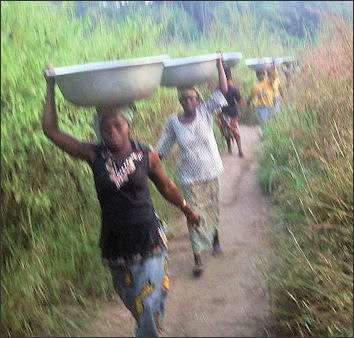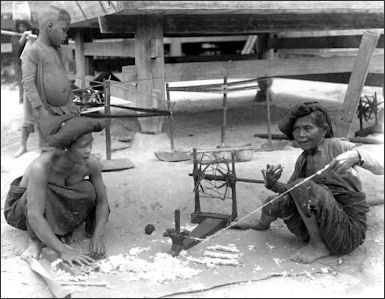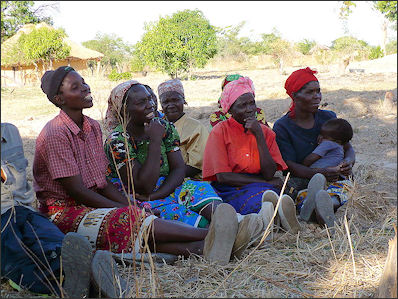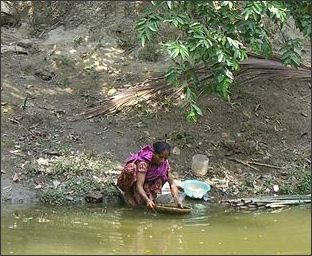VILLAGE WOMEN

Head transport in Ivory Coast Village women are generally uneducated and have few options in life. Their worth is measured by how hard they work and how many children they produce. At birth, they are often regarded as disappointments by families who want a son. After that they are regarded as property of their fathers, brothers or husbands and can't go anywhere without their permission.
Beauty and intelligence are probably less prized in the developing countries than in the developed world. A good bride in many countries is considered to be a woman who can "cook, look after her husband and give him sons."
Rural women and urban women often live in separate worlds. In urban areas women dress in Western clothes and sometimes have careers and work as doctors, professors, journalists, researchers, and lawyers. In the rural areas women dress in modest traditional clothes and perform tasks traditionally associated with village and family life.
Women traditionally have socialized with each other, laughing and telling stories, while doing chores. When they have some free time they like to do things like meet at a friend’s house and try cosmetics and fingernail polish. Women usually speak little to male visitors and are reluctant to accept thanks from them. Women are more open and friendly with women visitors.
Puberty tends to start earlier as countries develop and children's diets improve; in China, the starting age has fallen from about 14.5 in the 1970s to 12 1/2 years old. Meanwhile, the average marriage age has edged up, from 20 in the 1970s to 22 now, extending the time that many young people can be sexually active but unmarried. Li Shuzhuo, a demographer at the Institute for Population and Development Studies in Xian, says it is clear that there has been a big shift from post-marriage to pre-marriage abortions. [Source: Alexa Olesen Associated Press , January 10, 2011]
Village Women and Work
Among the daily chores performed by village women are grooming and washing the children, preparing drinks for the men, making meals, cleaning the corrals of the animals, tending the family's crops, selling and buying stuff at the market, milking goats, making butter or cheese, collecting and processing dung, washing, pounding rice or grain, spinning cloth, threshing or separating beans from their pods, hoeing and weeding the fields, carrying firewood, transporting the harvest, fetching water, housekeeping and looking after the children.
In many societies women do two-thirds of the farm labor. During the harvesting and planting season men and women work about equally but when those tasks are done women do much of the day-to-day farming chores while the men often goof around. Women often do so much of the farm work men are often encouraged not to come to agricultural meeting sponsored by aid workers.
Women often carry stuff with basket on their back supported by a strap around forehead. They also carry young children on their backs, in slings, when they perform chores such as butter churning. Some women can carry 70 pounds on their heads.
Women have few opportunities to make money other than selling stuff at the market or on the streets in a town or city, making clothes or handicrafts or performing menial labor.
Women and Washing
Washing at a Bangladeshi village One of the primary responsibilities of village women and girls is making sure there is enough water for washing, cleaning, cooking and drinking. Women carry water from a communal well or stream to their homes everyday. Most of the time there is a well in the village. But not always. Sometimes women and girls walk several miles fetching water. One male villager told National Geographic, "Our women spend half their lives going for water."
Women often carry water on their head with a container balanced on a cloth wrapped in a circle on the top of their head. Experienced women can carry the load without using their hands. Less experienced women need to use their hands.
Village women seem to spend more time washing clothes by hand than doing anything else. From dawn to dusk the shores of lake and rivers are lined with women scrubbing, ringing and rinsing their families clothes. These women are also skilled at taking a baths in rivers and streams with their clothes on.
Many towns and villages have a collective washing area in the middle of town where women gather to do their laundry in cement sinks while chatting and telling stories.
Fetching Water
Reporting from southern Ethiopia, Tina Rosenberg wrote in National Geographic, “Aylito Binayo's feet know the mountain. Even at four in the morning she can run down the rocks to the river by starlight alone and climb the steep mountain back up to her village with 50 pounds of water on her back. She has made this journey three times a day for nearly all her 25 years. So has every other woman in her village of Foro, in the Konso district of southwestern Ethiopia. Binayo dropped out of school when she was eight years old, in part because she had to help her mother fetch water from the Toiro River. The water is dirty and unsafe to drink; every year that the ongoing drought continues, the once mighty river grows more exhausted. But it is the only water Foro has ever had. [Source: Tina Rosenberg, National Geographic, April 2010]

Pumping water at Jukwa village, Ghana The task of fetching water defines life for Binayo. She must also help her husband grow cassava and beans in their fields, gather grass for their goats, dry grain and take it to the mill for grinding into flour, cook meals, keep the family compound clean, and take care of her three small sons. None of these jobs is as important or as consuming as the eight hours or so she spends each day fetching water.
Where clean water is scarcest, fetching it is almost always women's work. In Konso a man hauls water only during the few weeks following the birth of a baby. Very young boys fetch water, but only up to the age of seven or eight. The rule is enforced fiercely — by men and women. "If the boys are older, people gossip that the woman is lazy," Binayo says. The reputation of a woman in Konso, she says, rests on hard work: "If I sit and stay at home and do nothing, nobody likes me. But if I run up and down to get water, they say I'm a clever woman and work hard."
On a hot late afternoon I go with her to the river, carrying an empty jerry can. The trail is steep and in places slippery. We scramble down large rocks alongside cacti and thornbushes. After 50 minutes we reach the river — or what is a river at certain times of the year. Now it is a series of black, muddy pools, some barely puddles. The banks and rocks are littered with the excrement of donkeys and cows. There are about 40 people at the river, enough so that Binayo decides that the wait might be shorter upstream. The wait is especially long early in the morning, so Binayo usually makes her first trip before it is light, leaving her son Kumacho, a serious-faced little man who looks even younger than his four years, in charge of his younger brothers.
We walk another ten minutes upstream, and Binayo claims a perch next to a good pool, one fed not only by a dirty puddle just above but also a cleaner stream to the side. Children are jumping on the banks, squishing mud through their feet and stirring up the water. "Please don't jump," Binayo admonishes them. "It makes the water dirtier." A donkey steps in to drink from the puddle feeding Binayo's pool. When the donkey leaves, the women at the puddle scoop out some water to clear it, sending the dirty water down to Binayo, who scolds them.
After half an hour it is her turn. She takes her first jerry can and her yellow plastic scoop. Just as she puts her scoop in the water, she looks up to see another donkey plunk its hoof into the pool feeding hers. She grimaces. But she cannot wait any longer. She does not have the luxury of time. An hour after we arrive at the river, she has filled two jerry cans — one for her to carry back up, one for me to carry for her. She ties a leather strap around my can and puts it on my back. I am grateful for the smooth leather — Binayo herself uses a coarse rope. Still, the straps cut into my shoulders. The plastic can is full to the top, and the 50-pound load bounces off my spine as I walk. With difficulty, I make it halfway up. But where the trail turns steepest I can go no farther. Sheepishly, I trade cans with a girl who looks to be about eight, carrying a jerry can half the size of mine. She struggles with the heavier can, and about ten minutes from the top it is too much for her. Binayo takes the heavy jerry can from the girl and puts it on her own back, on top of the one she is carrying. She shoots us both a look of disgust and continues up the mountain, now with nearly 12 gallons of water — a hundred pounds — on her back.
Women, Weaving and Spinning

spinning cloth in Karolanden Sumatra Weaving is the interlocking at right angles of two sets of fibers to make cloth or a similar material. Spinning is the process by which fibers are drawn and twisted into string, yarn or thread. These tasks have traditionally been done at home by women with looms and spinning devices. The advantage with working at home is that women could work and care for their children at the same time and do weaving and spinning when they are not doing other chores
To make yarn the old-fashion way: 1) After a sheep is sheared the wool fibers are cleaned and straightened by carding with a toothed card (a sort of brush with stiff bristles). 2) The wool is then rolled between two cards to produce a thin fiber-like piece of wool called a sliver. 3) The sliver is placed on a spike called a distaff. 4) A strand of wool is then pulled off and a weight known as whorl is attached to it. 5) The strand is twisted into a thread by spinning it with the thumb and forefinger. Since each thread is made this way, you can how time consuming it must have been to make a piece of cloth.
To make cloth the old-fashion way: 1) Threads are placed on a warp-weighted loom. Warps are the downward hanging threads on a loom, and they are set up so that every other thread faces forward and the others are in the back. 2) A weft (horizontal thread) is then taken in between the forward and backward row of warps. 3) Before the weft is threaded through in the other direction, the position of the warps is changed with something called a heddle rod. This simple tool reverses the warps so that the row in the front is now in the rear, and visa versa. In this way the threads are woven in a cross stitch manner that holds them together and creates cloth. The cloth in turn is all kinds of things.
The women sometimes use natural dies. Red is made with madder or kermes (an insect found in kermes oak); yellow with wild chamomile, saffron, vine leaves and the rinds of pomegranates; black from acorns; and blue from plants with indigo.
Natural dyes produce richer and more natural colors. The depth of color can be controlled by the type of water — rain, river or spring — used. Plant dyes though are notoriously unpredictable. They are affected by weather conditions, soil and when they are harvested. They have mostly been replaced by chemical dyes.
Lack of Rights for Women and Domestic Violence in the Developing World

Zambian women Women make up half the world's population and do two-thirds of the work, but earn one tenth the income and own one hundredth of the property. On average. women workers earn about 40 percent less than their male counterparts for similar work.
Women are often powerless. They make few decisions about their own lives, have little status or prestige, and are respected most if they suffer and endure the hardships of life to keep their family together.
Women have very few rights. Girls generally leave school earlier, receive less food and medical care, and are forced to work sooner than boys. In some places, women are not allowed to leave their homes and husbands have the right to restrict their wives from participating in activities outside the home. In some poor households women are sometimes relegated to rooms in the back of house with the chickens and goats.
Domestic violence is a problem in the developing world. One doctor who treated villagers said that three fourths of all the females treated for injuries at his hospital were beaten by their spouses. In some places, if a man dies in an accident or even from natural causes his wife is blamed for the death and ostracized by her village even if she had nothing to do with it.
In some places, a husband who kills his wife for committing adultery is regarded as having done the honorable thing while a man can only be penalized for adultery if his mistress is living within the family house and even then he is often only given a light sentence. Women who strike back at the unfaithful husbands are sometimes looked upon with contempt because they didn't turn a blind eye to their transgressions as they are expected to do.
Working Women

worker at disk drives factory in China It is not unusual for girls to be pulled out of school when they are ten or so to work in the fields. When they are 14 or 15 they are sent off to work in factories far from their home towns
In China in imperial times women were prohibited from holding official position and prevented by foot binding from doing many kinds of physical labor. They worked hard at domestic chores and produced textiles for the home and to sell. The Communists claimed to give equal rights in regards to work and employment opportunities. Equality existed more in theory than in practice. Women toiled in factories and on farms and worked as teachers and doctors but held relatively few positions with power or real decision-making.
There are a fairly large number of female doctors in China. Even so women generally don’t hold very high-status positions or jobs. They are often encouraged to become secretaries, tour guides and hostess, not lawyers, managers and executives. Women are usually the last hired and the first laid off because unemployed women are considered less "socially destabilizing" than unemployed men.
Women in China traditionally control family finances. Millions of housewife have invested their family's money in real estate and stocks and four million operate private firms of a "substantial scale." A survey in 2000 by J. Walter Thompson on goals found 74 percent of the women interviewed ranked personal success first, 54 percent chose wealth and only 19 percent picked friendship.
See Working Women Under Labor or Women in China
Women's Health and Education in the Developing World
Women often die from botched abortions, complications during childbirth and other problems related to pregnancy, often as a result of poor health care or having babies too young or too close together. Women in some developing countries are 200 times more likely to die in childbirth than European women.
Women suffer more from high population growth than men. Mothers who have numerous pregnancies have a higher risk of dying, girls that grow up in large families are more likely to suffer, and woman that have pregnancies close together or give birth as teenagers are more likely to have health problems.
Education and Girls in the Developing World

Iranian studentsLiteracy rates for boys and men are generally higher than for girls and women. According to UNICEF, two thirds of the world’s illiterate people are women and girls.
Most girls that do attend school leave before they are teenagers. The decision to keep girls out of school is often made by fathers, who feel that boys are more likely to earn healthy incomes in the future and thus have a priority within families to get an education. Fathers also believe girls are more useful making money when they are young before they get married and leave the family.
Girls often can't go to school because they have to stay home to perform chores or take care of their younger siblings. Without school, young girls are condemned to a life of illiteracy and limited skills. This keeps society as a whole from developing and impedes the tackling of problems like population growth and infant and child mortality.
A higher percentage of students in rural schools are girls than years before. But they are still significantly outnumbered by boys. Educated girls marry later, have fewer children and are more likely to seek medical attention sooner. A skill as basic as sewing can help a girl get ahead in the future.
According to UNICEF 90 million girls worldwide are being excluded from primary school, primarily because of outdated female stereotypes and early pressure to get married. By contrast about 25 million boys are not receiving primary education.
Women, Education and New Birth Control Strategies
One factor that seems to make the greatest contribution towards lowering birth rates is increasing the health and status of women. Studies have shown that healthy women with a education and jobs are less likely to begin having children early than unhealthy, uneducated women without jobs. In Senegal, for example, women with no education have an average of seven children while those with 10 years of school have 3.6 children.
In recent years, the focus of population control has switched from promoting birth control to providing educational, political and economic opportunities to women as well as giving family planning advise. To fight overpopulation, family planning organizations are urging developing world governments to give women jobs and access to credit and land ownership.
Studies have also shown that when health services are improved for women — as well as for men and children — the birth rate goes down.
In 2009 the United Nations created a body devoted solely to women’s issues.
Image Sources: Wikimedia Commons
Text Sources: New York Times, Washington Post, Los Angeles Times, Times of London, Yomiuri Shimbun, The Guardian, National Geographic, The New Yorker, Time, Newsweek, Reuters, AP, Lonely Planet Guides, Compton’s Encyclopedia and various books and other publications.
Last updated January 2012

